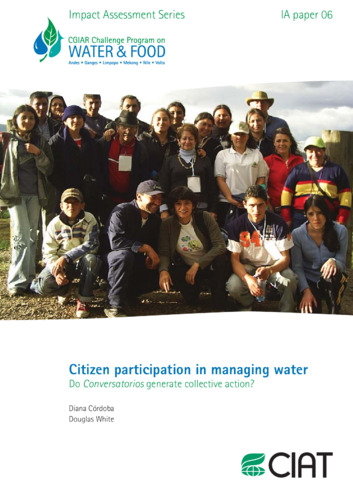Citizen participation in managing water: Do Conversatorios generate collective action?
Abstract
A central challenge for effective watershed management is improving the welfare of residents who live in upper catchments while providing adequate environmental goods and services to people and areas downstream. A CPWF project, Sustaining Collective Action Linking Economic and Ecological Scales in Upper Watersheds (SCALES), addressed this challenge in three sites. 1 This document is an evaluation of a project activity that intended to enhance collective action in one site: the Coello watershed of Colombia.
Collective action can influence how people use and manage natural resources. It is a process by which voluntary institutions (e.g., rules and regulations) are created and maintained, often with the aim of improving human and environmental welfare and, especially for water resources, it typically involves a broad range of stakeholders who control, use and benefit from water. Examples of stakeholders include government, private businesses, landowners, farmers, and city dwellers.
The SCALES project researched and fostered collective action. The Conversatorio of Acción Ciudadana (CAC) served as the collective action mechanism to promote civil society participation in public policy decisions. Supported by the Colombian constitution, the legal power of CACs enable communities to discuss policies and reach agreements with government authorities.
People in the Coello watershed confront water problems that affect their livelihoods. Contamination and deforestation are two major causes of water resource degradation, in terms of both water quality and flow regulation. Specifically, fertilizer contamination of water supplies and sedimentation of waterways negatively affect downstream communities. The watershed also faces competition for water supplies. Water is extracted from natural waterways for both rural irrigation and urban household consumption.
A CAC is more than a large meeting to talk and make decisions. The CAC is a four-phase process that enhances the effectiveness of local participation:
(1) awareness-raising, (2) capacity-building and preparation (3) CAC implementation, and (4) review and planning. The CAC mechanism has brought
together diverse actors and fostered collective action across spatial and social scales. Many types of actors have participated, including local NGOs, upstream and downstream community representatives, politically important actors (at municipal, provincial and national levels) and scientific experts in research and development (R&D).
The objective of this review is to evaluate the impact of the CAC process. Evaluation methods included analysis of SCALES project reports and documentation on impact pathways, interviews and social networks. The intended project outcomes, as identified by the project implementers themselves, served as the starting point for the analysis. These expectations were contrasted with identifiable project outcomes. A social network analysis reviewed contextual conditions, mechanisms of intervention, and processes that led to the project outcomes. The evaluation also analyzed interviews with project participants. Some interviews employed techniques of video data collection, where project participants 2011.04.22.CPWF WP-IAS-08.draftv3 CPWF Working Paper - Impact Assessment Series No. 06 vii interviewed key actors regarding their perceptions and opinions of project outcomes and likely impacts.
Results of the project evaluation reveal that the CAC process effectively fosters collective action in watersheds communities. Capacity-building activities of the project contributed to communities participating in meetings with multiple organizations and making collective decisions. In addition, dialogue and networking activities increased organizational and political support for communities and local NGOs. This is an example of higher-level organizations (i.e., sub-national, national and international) working with lower-level organizations and communities; in other words, cross-scale collaboration.
Key outputs of the CAC process included 27 agreements with government authorities with financial commitments of over US$2 million. These agreements included projects for conservation, resource management, agricultural production systems and potable water systems.
The project produced four outcomes:
1. Increased awareness of water issues amongst people in the watershed. Distinct problems and experiences from the upper, middle and lower areas of the watershed were shared. Better understanding of others’ perspectives provided incentives for communities to jointly resolve problems and establish agreements.
2. Strengthened links amongst community and environmental organizations. The CAC provided a forum for community-based organizations (CBOs) and non-government organizations (NGOs) to communicate and build support for their agendas with both communities and government agencies. Such interactions enabled organizations to establish partnerships and obtain additional public-sector funds.
3. Enhanced local capacities and relationships with authorities. New knowledge helped clarify citizen rights, along with roles and responsibilities of organizations. The CAC generated dialogue and, in turn, commitments of government organizations to work on issues raised by communities.
4. New priorities and commitments for environment-friendly land uses. The agenda of the CBOs, NGOs and public-sector agencies broadened beyond water to include land uses such as agriculture, power generation and forests. Specific
development and conservation practices included organic farming, waste management, forest management and reforestation.
Evaluation results show that the CAC process has the potential to become an international public good/method that can (a) facilitate community access to knowledge, technology and skills, and (b) enable them to participate in decision-making processes in managing water and other natural resources. Given the relatively short time frame between project and evaluation, impacts cannot be realistically assessed. Social change processes and associated impact require years to evolve and grow. Nevertheless, the project activities and outputs have laid important groundwork for longer-term economic, social and environmental impacts.
Although the CAC process benefits from the support of Colombian constitution, similar effective collective action projects could be achieved in other locations despite not receiving such support. Civic organizations (CBOs or NGOs) can influence government decisions. As lobbying pressures and accountability for actions increase, government agencies themselves will have greater incentive to perform. The CAC process connects the people with authorities, thereby improving decisions and actions.

